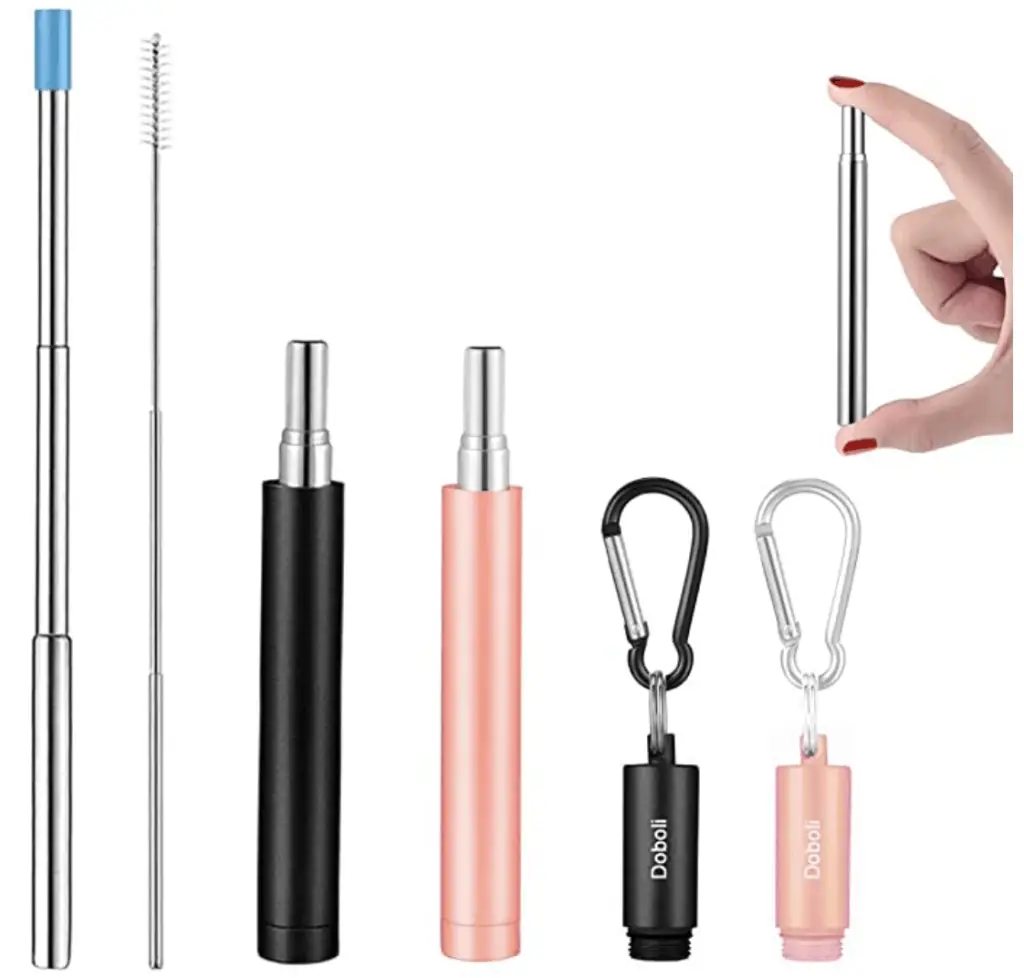“It’s only one straw,” said 7.7 billion people.
Paper straws are becoming all the rage, but are they really that much more sustainable than plastic straws? And what are these wheat straw things?
We all turned our backs on plastic when the video of the turtle with a straw in his nose went viral, but what other environmental effects do straws of different kinds, such as wheat straws/hay straws have and which is the most sustainable option?
Read More: 10 Eco-Friendly Gift Wrapping Ideas You Should Start Using
Keep reading to learn about the environmental effects of plastic, paper, and wheat straws (hay straws). By the end of this post you’ll know how you can reduce your carbon footprint with a few simple swaps.
Table of contents

Plastic Straws
We’ve all used them. Whether it was for a drink, arts and crafts, or spitballs, plastic straws are integrated into many of our lives.
So what’s the big deal with them? In this section, we’ll learn how plastic straws are made, how expensive they are to make, and what the environmental impact of them is.
How are plastic straws made?
Plastic straws are typically made from oil, a fossil fuel, which is a non-renewable resource.
This means that eventually, it will run out.
So all of those plastic cups, straws, and bags that we so readily throw away after one use, won’t be accessible forever.
If you want to see the straw making machine in action, check out this video.
How expensive are plastic straws to make?
Plastic straws cost about half of a cent to produce.
What is the environmental impact of plastic straws?
A single plastic straw can take 200 years to biodegrade.
Plastic straws are a single-use item (try and think about how many single-use items you use daily) which means that after one drink, art project, or cooking experiment, they’re into the trash and likely washed out into an ocean to sent to a landfill.
Americans alone use 500 million straws every day which according to GetGreenNow is enough to circle the earth 2.5 times.
In short, plastic straws are horrendous for the environment and just like other single-use plastics, they should be avoided like the plague. Because of supply and demand, if we use alternatives and make it clear that we won’t be using single-use plastics, they won’t appear as readily in our world.
If Queen Victoria used a plastic straw at her coronation in 1873, we could have it on display today. – SciTech europa
Read More: How to Have a Zero Waste Period – For Everyday Life and Travelers

But what exactly is the environmental impact of plastic?
Here are a few fast facts to help you better understand the impact that plastic has on your home (aka Earth).
- The plastics industry relies on nonrenewable (oil and gas found through fracking and drilling) substances to create its products (ref pg 13)
- These non-renewable substances account for 90% of the feedstock (what is used to make the plastic) (ref pg 13)
- It’s estimated that by 2050 there will be more plastic in the oceans than fish (ref)
- Plastic has been found in the most remote places in the world, from Mount Everest to the Mariana Trench (ref)
- More than 90% of the world’s seabirds have trash in their guts which will inevitably kill them (ref)
- Half of the world’s sea turtles have plastic in their stomachs (ref)
- Plastic straws cannot be recycled by most facilities (ref)
Think about all those poor sea creatures! And if you want to help the sea creatures, even more, consider switching to a vegetarian or vegan diet. Not consuming animals or their mass-produced byproducts is the best way to protect them and their environment.
Read More: Discover 16 Sustainable Travel Tips as Recommended by Travel Bloggers

Paper Straws
You’re probably familiar with paper straws. They became quite common in 2019 and don’t look to be stopping. But are they actually any better than plastic straws?
Let’s find out!
How are paper straws made?
It’s a fairly straightforward factory process that involves the cutting of paper and rolling it as a straw. This video gives an interesting view of how paper straws are made.
You can also make your own paper straws at home. Keep in mind that there is still waste created, although you’ll at least be putting in the energy yourself.
How much do paper straws cost to make?
Paper straws cost about 2.5 cents to make according to CNBC.
What is the environmental impact of paper straws?
A paper straw takes 3 days to biodegrade.
According to one article, the amount of energy needed to make one paper straw could be used to make 1,000 plastic straws so although paper is recyclable and biodegrades, the amount of energy needed to produce these paper straws is still astounding.
So which is the better of two evils?
Additionally, deforestation is a byproduct of paper production. Sigh. Paper straws can’t possibly be the best option.
Wheat Straws
Wheat-based products seem to be becoming quite popular on the market. Wheat-based reusable straws and coffee cups are available to purchase on Amazon or through sites that do a little more to support small businesses like Etsy (US & UK) or Not on the High Street (UK). Be sure to check out Strawphisticated’s wheat straws to directly support. small business. You can also get $5 off your first purchase of Strawphisticated with the code voyaging-herbivore
Keep reading to learn more!


As it turns out, wheat-based straws and coffee cups actually feel just like plastic. Smooth and well, plastic-like. So you get the same results but with a renewable resource. Neato!
But, there are also single-use wheat straws (hay straws). Keep reading to see why these straws are ideal in situations (or for people) who insist on single-use items.
How are wheat straws made?
A wheat straw, otherwise known as a hay straw, is literally just that – a piece of wheat stem. I first had one at a sustainable and vegan pub in London. They don’t get soggy like paper straws (although as Jack will tell you, they’re equally pleasing to chew on). They can also be cut to any size.
Wheat or hay straws are a byproduct of the wheat production process. Stems are cut off and because they aren’t really profitable, they might be used as animal bedding or go straight into the compost heap.
Or as straws! Minimal additional processing required.
I have yet to find a video of wheat straw production so if you have any info please do let us know!
Read More: Eco Travel Products: 12 Sustainable and Vegan Travel Products You Need
How much do wheat straws cost to make?
Because wheat straws are fairly new to the market, we haven’t been able to find a price of production per straw. If you have this info, please let us know.
In terms of actually purchasing wheat straws, they are by no means expensive. It’s about the same as your average pack of paper straws.
What is the environmental impact of wheat straws?
Wheat straws compost in 1-2 months.
Wheat straws are actually just a byproduct of wheat production, so no deforestation (minus clearing forests for wheat fields – but you’ve got to pick your battles) occurs. Essentially, no additional plants have to be planted or cut down in order to make most wheat straws.
“In some countries like China, the stem byproduct is disposed of by burning, which contributes to air pollution. By creating a market for this unwanted byproduct, we’re eliminating the need to burn it, and helping to cut back on air pollution!” – HayStraws
So all in all, wheat (hay) straws are likely the most ethical and sustainable straw choice and they’re a great compromise between paper and plastic.




How Can You Help?
So we’ve learned that plastic is bad, paper could be better, and wheat or hay does the trick, but of course, wheat straws are hard to come by when out on the town.
Invest in a reusable straw! They’ll last you a lifetime (unless you leave them in a cup at the movies like moi) and really are quite inexpensive.
Bring your own cup when you get coffee or a drink. Jack and I have stopped purchasing drinks that come in plastic cups, even if they provide a paper straw.
The more that we say no to single-use plastic the less readily available it will become. Not to mention, most places will give you a discount if you use your own cup.
Traveling by plane? Invest in a collapsible cup that holds hot and cold drinks. You won’t ever need to accept a single-use cup from a steward persona gain.
Does your local grocery store wrap every fruit and veggie in plastic? See if there is a place near you that sells bulk foods. They’re often cheaper and you get a better selection of which specific fruit/veg you want.
Read More: 10 Cheap Ways to Reduce Plastic While Traveling
Where to Buy Eco Friendly Straws
- Wheat drinking straws from Amazon
- Hay drinking straws on Amazon
- Agave fiber straws from Agave Straw Co.
- Compostable Wheat Drinking Straws from Not on the High Street
- Wheat drinking straws from Eco Mad
Sustainable Living Must-Have Items
Here are a few items that I have and absolutely love! These hay straws are great if you’re having a party and want something disposable and biodegradable that won’t get soggy.
Or, if you’re like me and would never have more than two people over at once, invest in some metal straws (they come with a cleaning brush) so there’s nothing to throw out!
The collapsible travel straws are great to toss in your bag so whether they’re dirty or clean, they won’t get on the rest of your stuff.
A wheat thermos is also incredibly handy and contributes to a cleaner environment while being affordable.
Finally, don’t forget a collapsible silicone cup so you never need to use a single-use cup on a plane again.
Read More: How to Track and Offset Your Carbon Footprint
Ready to Live a Sustainable Life?
Now that you know the benefits of hay straws, why not learn more about what you can do to help the environment? Check out the posts below to keep learning!




Free Resources





Follow us on Pinterest and Pin Our Eco Wheat Straw Guide for Later



And as always, you can find more sustainable travel content on Instagram @VoyagingHerbivore, Youtube, and TikTok and to get updates straight to your inbox, enter your email below.
If you found this guide helpful and want to help us keep these resources free,
please consider making your next Amazon, Expedia, Hostel World, Etsy, Trivago, and Booking.com purchase through our links (just click right on those words – you can do it right now and unless you clear your cookies before your next purchase, it will remember). It costs you no extra and gives us a small commission. Thank you!


















Leave a Reply